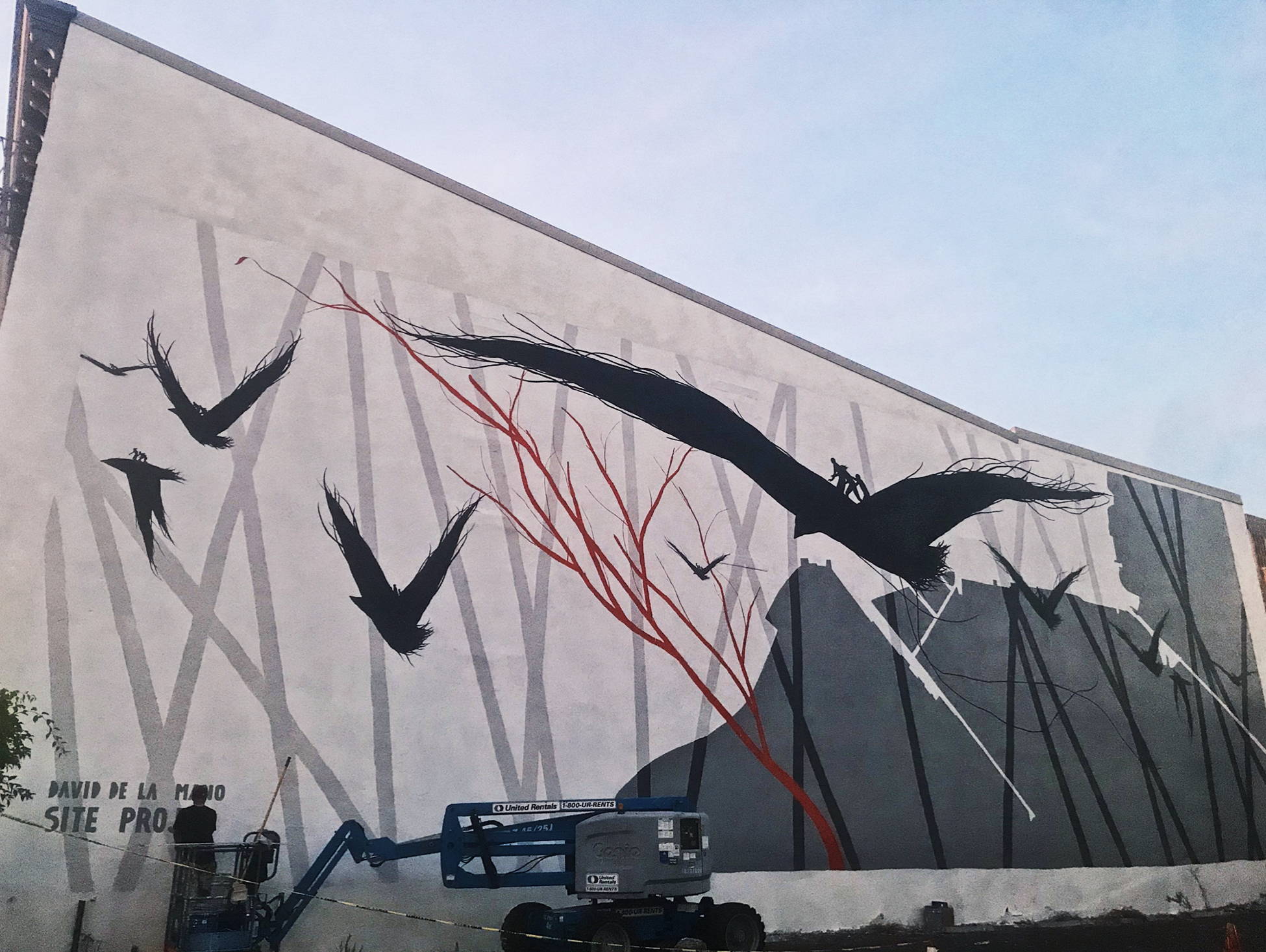
Gamze Kazakoglu, Contributing Photographer
On Saturday, David de la Mano, a Spanish contemporary artist, added the final touches to his new mural at 33 Crown St.
Over the previous week, de la Mano had painted a mostly black-and-white depiction of a large eagle, several small birds and human figures. Though the connection is not explicit, the mural is de la Mano’s homage to New Haven native William Lanson, a self-taught African American engineer and entrepreneur who was particularly active in the 1810s and 1820s. Lanson is most famous for helping expand commerce in the city by modernizing New Haven’s then-shallow harbor and expanding Long Wharf by 1,350 feet.
Site Projects, a New Haven public art nonprofit, commissioned de la Mano to paint a mural in the Elm City about two years ago.
After logistical problems and derailed plans due to the pandemic — de la Mano, who was working on a project in Spain, was barred from coming to the United States due to the travel restrictions on European passengers implemented in March — the muralist was eventually able to make his way to New Haven in October by going through Uruguay. While ideas for the project changed multiple times, de la Mano and Site Projects eventually agreed on a design that depicted Lanson in a metaphorical manner.
“Lanson is the big bird. He can go up and has the vision of the city and he made it finally,” de la Mano said as he looked up toward his project. “He could fly, and I did it with this bird metaphor. And I tried to represent this with other birds to show how people can use his way, can fly going after dreams.”
De la Mano was sure to include Lanson’s tragic and darker years of his life in the mural, too. Lanson died a poor man; mounting debts, health issues and accusations of illegal activities led him to lose his properties. De la Mano tried to represent this aspect of the New Havener’s life with a red-colored tree that stands out from the mural’s otherwise monochrome design.
De la Mano said he decided to depict Lanson in a figurative manner in part because there are no images left of him. Earlier this year, the New Haven City Plan Department and the Amistad Committee, a Connecticut-based non-profit that educates the public about African American history, hired Oakland-based sculptor Dana King to make a statue of Lanson. King based Lanson’s sculpture on archival notes she found. The sculpture was unveiled to the public in September.
Gabriel DaSilva, the founder of DaSilva Gallery in Westville and a board member of Site Projects, originally contacted de la Mano through a mutual acquaintance, artist Faring Purth. DaSilva became a strong proponent of bringing de la Mano to New Haven. After seeing the artist’s work, he said he was most drawn to its simple yet “effective” style.
DaSilva said de la Mano’s style is valuable for public art because it “leav[es] the door open to interpretation.”
“I don’t think people who walk by understand the mural right away, which is one thing we wanted to accomplish,” DaSilva said. “We want to have conversation, which is the most important thing for us to engage with the community.”
Laura Clarke, the executive director and co-founder of Site Projects, said she believes the mural’s value is dualistic: commemorating Lanson and maintaining the ability to attract multiple interpretations.
“I would never ever underestimate what an 8- or 10-year-old kid could see on that mural. So I never interpret the mural for anyone, but if anyone asks me I tell them what I see in the mural,” Clarke said.
Clarke added that the mural is also “timely.” Lanson and his engagement with New Haven was a “very important thing” to talk about in the time of the Black Lives Matter movement, Clarke said. She said that acknowledging Lanson’s story is important because it is a “real indication of white and Black relationships in New Haven going back to the 1800s.”
Jeff Spiritos, the owner of the apartment building at 33 Crown St., said he was excited by the opportunity to support a work that commemorates Lanson, who he believes was a “successful, Black businessman who became mistreated because of slavery and practices against Black Americans.”
“When I immediately looked up, I was very excited to support a project to and bring attention, commemorate the historic and prominent American individual,” Spiritos said. “His story deserves to be told and David de la Mano’s visual is, I think, a beautiful way to tell it.”
Elihu Rubin, associate professor of urbanism at the Yale School of Architecture, said the mural both adds to New Haven’s image as an arts and culture center to outsiders and creates a new point of interest for city residents.
“It refers to the city’s history, yet it is also a poetic image of these birds, ravens, black birds, it’s not overly jubilant, it almost has a gothic or noir feeling to it, which I think is also a kind of true to the city in its own way too,” Rubin said.
The underwriting support for the project’s $20,000 budget was provided by the COULD BE Fund of the Economic Development Council.
Gamze Kazakoglu | gamze.kazakoglu@yale.edu
Interested in getting more news about New Haven? Join our newsletter!







